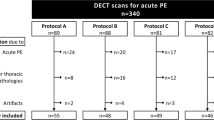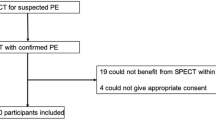Abstract
Objectives
The purpose of this study was to determine whether dual-energy computed tomography (DECT) angiography could differentiate pulmonary thromboembolism (PTE) from pulmonary artery sarcoma (PAS).
Methods
We prospectively enrolled 19 patients that had a filling defect in the main pulmonary artery on DECT. Six patients who had PAS and underwent DECT were retrospectively enrolled for comparison. Pathological results or follow-up CT after anticoagulation therapy were used to make the final diagnosis. Two investigators measured the following parameters at the filling defect in the main pulmonary artery: CT attenuation density [Hounsfield units (HU)], iodine-related HU (IHU) and iodine concentration (IC, mg/ml).
Results
From a total of 25 patients (M:F = 10:15; mean age, 65 years old), 19 were categorised into the PTE group and six were categorised into the PAS group. The mean HU values were not significantly different between the PTE and PAS groups (45.5 ± 15.9 vs 47.1 ± 9.2 HU; P = 0.776). However, the mean IHU and IC values of the lesions were significantly different between the PTE and PAS groups (10.6 ± 7.2 vs 27.9 ± 9.1 HU; P = 0.004, and 0.61 ± 0.39 vs 1.49 ± 0.57; P = 0.001).
Conclusions
DECT angiography using a quantitative analytic methodology can be used to differentiate PTE and PAS.
Key Points
• DECT can be useful for differentiation of PAS and PTE.
• With quantitative analysis, DECT offers tissue characterisation by detecting lesion parameter increases.
• The patients without predisposing factors for PTE can be candidates for DECT.





Similar content being viewed by others
References
Coli A, Parente P, Bigotti G (2007) Pulmonary artery sarcoma: an insidious tumor still diagnosed too late. Analysis of the literature and report of a case. J Exp Clin Cancer Res 26:151–156
Blackmon SH, Rice DC, Correa AM et al (2009) Management of primary pulmonary artery sarcomas. Ann Thorac Surg 87:977–984
Mussot S, Ghigna MR, Mercier O et al (2013) Retrospective institutional study of 31 patients treated for pulmonary artery sarcoma. Eur J Cardiothorac Surg 43:787–793
Wong HH, Gounaris I, McCormack A et al (2015) Presentation and management of pulmonary artery sarcoma. Clin Sarcoma Res 5:3
Furest I, Marin M, Escribano P, Gomez MA, Cortinac J, Blanquer R (2006) Intimal sarcoma of the pulmonary artery: a rare cause of pulmonary hypertension. Arch Bronconeumol 42:148–150
Chhaya NC, Goodwin AT, Jenkins DP, Pepke-Zaba J, Dunning JJ (2006) Surgical treatment of pulmonary artery sarcoma. J Thorac Cardiovasc Surg 131:1410–1411
Gutierrez A, Sauler M, Mitchell JM et al (2014) Unresolved pulmonary embolism leading to a diagnosis of pulmonary artery sarcoma. Heart Lung 43:574–576
Cox JE, Chiles C, Aquino SL, Savage P, Oaks T (1997) Pulmonary artery sarcomas: a review of clinical and radiologic features. J Comput Assist Tomogr 21:750–755
Scheffel H, Stolzmann P, Plass A et al (2008) Primary intimal pulmonary artery sarcoma: a diagnostic challenge. J Thorac Cardiovasc Surg 135:949–950
Gan HL, Zhang JQ, Huang XY, Yu W (2013) The wall eclipsing sign on pulmonary artery computed tomography angiography is pathognomonic for pulmonary artery sarcoma. PLoS One 8, e83200
Yi CA, Lee KS, Choe YH, Han D, Kwon OJ, Kim S (2004) Computed tomography in pulmonary artery sarcoma: distinguishing features from pulmonary embolic disease. J Comput Assist Tomogr 28:34–39
Caraway NP, Salina D, Deavers MT, Morice R, Landon G (2015) Pulmonary artery intimal sarcoma diagnosed using endobronchial ultrasound-guided transbronchial needle aspiration. Cytojournal 12:3
Attina D, Niro F, Tchouante P et al (2013) Pulmonary artery intimal sarcoma. Problems in the differential diagnosis. Radiol Med 118:1259–1268
Johnson TR, Krauss B, Sedlmair M et al (2007) Material differentiation by dual energy CT: initial experience. Eur Radiol 17:1510–1517
Kim HK, Choi YS, Kim K et al (2008) Surgical treatment for pulmonary artery sarcoma. Eur J Cardiothorac Surg 33:712–716
Kruger I, Borowski A, Horst M, de Vivie ER, Theissen P, Gross-Fengels W (1990) Symptoms, diagnosis, and therapy of primary sarcomas of the pulmonary artery. Thorac Cardiovasc Surg 38:91–95
Parish JM, Rosenow EC 3rd, Swensen SJ, Crotty TB (1996) Pulmonary artery sarcoma. Clinical features. Chest 110:1480–1488
Castaner E, Gallardo X, Rimola J et al (2006) Congenital and acquired pulmonary artery anomalies in the adult: radiologic overview. Radiographics 26:349–371
Walley VM, Virmani R, Silver MD (1990) Pulmonary arterial dissections and ruptures: to be considered in patients with pulmonary arterial hypertension presenting with cardiogenic shock or sudden death. Pathology 22:1–4
Mohammad K, Sahlol M, Egiebor O, Sadikot RT (2009) Idiopathic pulmonary artery dissection: a case report. J Med Case Rep 3:7426
Neimatallah MA, Hassan W, Moursi M, Al Kadhi Y (2007) CT findings of pulmonary artery dissection. Br J Radiol 80:e61–e63
Stern EJ, Graham C, Gamsu G, Golden JA, Higgins CB (1992) Pulmonary artery dissection: MR findings. J Comput Assist Tomogr 16:481–483
Anderson MB, Kriett JM, Kapelanski DP, Tarazi R, Jamieson SW (1995) Primary pulmonary artery sarcoma: a report of six cases. Ann Thorac Surg 59:1487–1490
Khawar MU, Bhardwaj B, Bhardwaj H (2015) Pulmonary artery sarcoma: not every filling defect is a pulmonary thromboembolism. J Thorac Oncol 10:218–219
Wittram C, Maher MM, Yoo AJ, Kalra MK, Shepard JA, McLoud TC (2004) CT angiography of pulmonary embolism: diagnostic criteria and causes of misdiagnosis. Radiographics 24:1219–1238
Ito K, Kubota K, Morooka M et al (2009) Diagnostic usefulness of 18F-FDG PET/CT in the differentiation of pulmonary artery sarcoma and pulmonary embolism. Ann Nucl Med 23:671–676
Sandhu A, Yates TJ, Kuriakose P (2008) Pulmonary artery sarcoma mimicking a pulmonary embolism. Indian J Cancer 45:27–29
Chong S, Kim TS, Kim BT, Cho EY, Kim J (2007) Pulmonary artery sarcoma mimicking pulmonary thromboembolism: integrated FDG PET/CT. AJR Am J Roentgenol 188:1691–1693
Allen S, Todd J, Copley S, Al-Nahhas A (2005) F-18 FDG uptake in bilateral pulmonary artery leiomyosarcomata, one mimicking a pulmonary embolus. Clin Nucl Med 30:418–419
Kamel EM, McKee TA, Calcagni ML et al (2005) Occult lung infarction may induce false interpretation of 18F-FDG PET in primary staging of pulmonary malignancies. Eur J Nucl Med Mol Imaging 32:641–646
Wittram C, Scott JA (2007) 18F-FDG PET of pulmonary embolism. AJR Am J Roentgenol 189:171–176
Kacl GM, Bruder E, Pfammatter T, Follath F, Salomon F, Debatin JF (1998) Primary angiosarcoma of the pulmonary arteries: dynamic contrast-enhanced MRI. J Comput Assist Tomogr 22:687–691
Wu HW, Cheng JJ, Li JY, Yin Y, Hua J, Xu JR (2012) Pulmonary embolism detection and characterization through quantitative iodine-based material decomposition images with spectral computed tomography imaging. Invest Radiol 47:85–91
Lu GM, Wu SY, Yeh BM, Zhang LJ (2010) Dual-energy computed tomography in pulmonary embolism. Br J Radiol 83:707–718
Pontana F, Remy-Jardin M, Duhamel A, Faivre JB, Wallaert B, Remy J (2010) Lung perfusion with dual-energy multi-detector row CT: can it help recognize ground glass opacities of vascular origin? Acad Radiol 17:587–594
Lu GM, Zhao Y, Zhang LJ, Schoepf UJ (2012) Dual-energy CT of the lung. AJR Am J Roentgenol 199:S40–S53
Kim SS, Hur J, Kim YJ, Lee HJ, Hong YJ, Choi BW (2014) Dual-energy CT for differentiating acute and chronic pulmonary thromboembolism: an initial experience. Int J Cardiovasc Imaging 30:113–120
Chai X, Zhang LJ, Yeh BM, Zhao YE, Hu XB, Lu GM (2012) Acute and subacute dual energy CT findings of pulmonary embolism in rabbits: correlation with histopathology. Br J Radiol 85:613–622
Grazioli V, Vistarini N, Morsolini M et al (2014) Surgical treatment of primary pulmonary artery sarcoma. J Thorac Cardiovasc Surg 148:113–118
Bleisch VR, Kraus FT (1980) Polypoid sarcoma of the pulmonary trunk: analysis of the literature and report of a case with leptomeric organelles and ultrastructural features of rhabdomyosarcoma. Cancer 46:314–324
Acknowledgements
The scientific guarantor of this publication is Jin Hur, MD, PhD. The authors of this manuscript declare no relationships with any companies whose products or services may be related to the subject matter of the article. This study has received funding by a faculty research grant from Yonsei University College of Medicine (6-2012-0105). No complex statistical methods were necessary for this paper. Institutional Review Board approval was obtained. Written informed consent was obtained from all patients for prospective study. For retrospective study, written informed consent was waived by the Institutional Review Board. Methodology: prospective and retrospective, diagnostic or prognostic study, performed at one institution.
Author information
Authors and Affiliations
Corresponding author
Rights and permissions
About this article
Cite this article
Chang, S., Hur, J., Im, D.J. et al. Dual-energy CT-based iodine quantification for differentiating pulmonary artery sarcoma from pulmonary thromboembolism: a pilot study. Eur Radiol 26, 3162–3170 (2016). https://doi.org/10.1007/s00330-015-4140-2
Received:
Revised:
Accepted:
Published:
Issue Date:
DOI: https://doi.org/10.1007/s00330-015-4140-2




